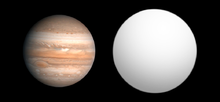WASP-18b
WASP-18b 목성과 WASP-18b의 크기 비교. | |
| 디스커버리 | |
|---|---|
| 검색 대상 | 헬리에 외 연구진 ([1]Super WASP |
| 발견일자 | 2009년[1] 8월 27일 |
| 운송[1](이차 일식 포함) | |
| 궤도 특성 | |
| 아파스트론 | 0.02045 AU(3,059,000km) |
| 페리아스트론 | 0.02007 AU(3002,000km) |
| 0.02026 ± 0.00068AU(3,031,000 ± 102,000km)[2] | |
| 편심성 | 0.0092 ± 0.0028[2] |
| 0.94145455+0.00000087 −0.00000132[3]d 22.59487시간 | |
| 기울기 | 86 ± 2.5[2] |
| 96 ± 10[2] | |
| 별 | WASP-18 |
| 물리적 특성 | |
평균 반지름 | 1.106+0.072 −0.054[2] RJ |
| 미사 | 10.3 ± 0.69[2] MJ |
| 온도 | 2500±200[4] |
WASP-18b는 궤도 주기가 하루 미만인 것으로 유명한 외계 행성이다. 행성과 갈색 왜성 사이의 경계선 바로 아래 10개의 목성 질량에 해당하는 질량, 약 13개의 목성 질량을 가지고 있다.[1] 조수 감속 때문에, 그것은 소용돌이치며, 결국 백만 년도 안 되어 그것의 숙주 별인 WASP-18과 합쳐질 것으로 예상된다.[1] 이 행성은 그 별에서 약 310만 km (190만 mi; 0.021 AU) 떨어져 있으며, 지구로부터 약 410광년 (130파섹) 떨어져 있다. 영국 킬 대학의 천체물리학 교수인 코엘 헬리에가 이끄는 팀에 의해 발견되었다.[1]
킬과 메릴랜드 대학의 과학자들은 이 행성의 발견이 (생명의 0.1%도 채 남지 않은) 예상 소멸 직전에 우연히 이루어졌는지, 아니면 WASP-18에 의한 조석 방류가 실제로 천체물리학자들이 일반적으로 추정하는 것보다 훨씬 덜 효율적인지를 이해하기 위해 노력하고 있다.[1][5] 향후 10년 동안 이루어진 관측은 WASP-18b의 궤도가 붕괴되는 속도의 측정을 산출해야 한다.[6]
태양계에서 비슷한 상황을 보여주는 가장 가까운 예는 화성의 달 포보스다. 포보스는 달보다 40배 가까운 약 9,000km(5,600mi)의 거리에서 화성을 공전하고 있으며 [7]약 1,100만년 후에 파괴될 것으로 예상된다.[8]
2020년에 측정한 일사이드 온도는 3,029 ± 50 K(2,755.8 ± 50.0 °C; 4,992.5 ± 90.0 °F)[9]이다.
2012년 연구는 로시터-맥러플린 효과를 이용하여 행성의 궤도가 별의 적도면과 잘 정렬되어 있고, 13±7°[10]에 해당하는 오정렬이 있다는 것을 밝혀냈다.
참고 항목
참조
- ^ a b c d e f g Hellier, Coel; et al. (2009). "An orbital period of 0.94days for the hot-Jupiter planet WASP-18b" (PDF). Nature. 460 (7259): 1098–1100. Bibcode:2009Natur.460.1098H. doi:10.1038/nature08245. PMID 19713926.
- ^ a b c d e f "Notes for planet WASP-18b". The Extrasolar Planets Encyclopaedia. Retrieved 2009-09-15.
- ^ McDonald, I.; Kerins, E. (2018). "Pre-discovery transits of the exoplanets WASP-18b and WASP-33b from Hipparcos". Monthly Notices of the Royal Astronomical Society: Letters. 477 (1): L21–L24. arXiv:1803.06187. Bibcode:2018MNRAS.477L..21M. doi:10.1093/mnrasl/sly045.
- ^ Zhou, G.; Bayliss, D. D. R.; Kedziora-Chudczer, L.; Tinney, C. G.; Bailey, J.; Salter, G.; Rodriguez, J. (2015). "Secondary eclipse observations for seven hot-Jupiters from the Anglo-Australian Telescope". Monthly Notices of the Royal Astronomical Society. 454 (3): 3002–3019. arXiv:1509.04147. Bibcode:2015MNRAS.454.3002Z. doi:10.1093/mnras/stv2138.
- ^ Hamilton, Douglas P. (2009-08-27). "Extrasolar planets: Secrets that only tides will tell". Nature. Nature Publishing Group. 460 (7259): 1086–1087. Bibcode:2009Natur.460.1086H. doi:10.1038/4601086a. PMID 19713920.
- ^ Thompson, Andrea (2009-08-26). "Newfound Planet Might Be Near Death". Space.Com. Imaginova. Retrieved 2009-08-28.
- ^ 존슨, 존 주니어; 천체물리학자들은 태양에 너무 가까운 행성인 로스앤젤레스 타임즈 (Los Angeles Times, 2009년 8월 27일).
- ^ Sharma, Bijay Kumar (2008-05-10). "Theoretical Formulation of the Phobos, moon of Mars, rate of altitudinal loss". arXiv:0805.1454 [astro-ph].
- ^ Systematic phase curve study of known transiting systems from year one of the TESS mission, 2020, arXiv:2003.06407
- ^ Obliquities of Hot Jupiter host stars: Evidence for tidal interactions and primordial misalignments, 2012, arXiv:1206.6105
- ^ Landau, Elizabeth; Zubritsky, Elizabeth (29 November 2017). "Exoplanet Has Smothering Stratosphere Without Water". NASA. Retrieved 29 November 2017.
외부 링크
| 위키뉴스에는 다음과 같은 관련 뉴스가 있다. |
![]() Wikimedia Commons의 WASP-18b 관련 미디어
Wikimedia Commons의 WASP-18b 관련 미디어


